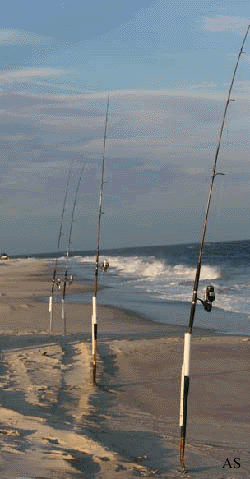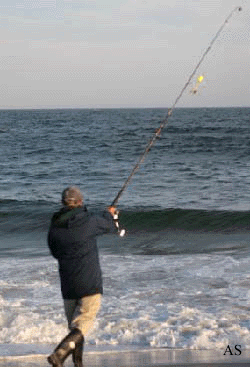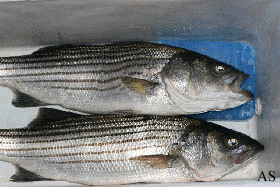
Surf Fishing Strategy
There are many ways to surf fish for striped bass. This is why it is so much fun. Probably the best strategy is to fish at night; but not everyone either likes to, or can do that.
What We Do
I often fish with my buddy John. We usually fish very early in the morning and try to catch the sunrise, or at dusk. On arriving at the beach, we make a decision to start with setting out bait rods, or throwing lures. If there is bird activity or action in the water we will start with lures or even break out the fly rods. Otherwise, we set out surf rods rigged with bait in sand spikes.
The spots we pick to fish are based on previous scouting trips at low tide that identified cuts, bars, points etc. These are spots that will produce some turbulence from the moving water of either an incoming or outgoing tide. The edges of bars are prime spots if they are within casting range.
John will put out two rods, as will I. We usually fish with clams, but sometimes fresh bunker when we can get it. We use high low rigs when fishing with clams, and fishfinder rigs when using bunker chunks. Unless we are targeting a particular spot of structure, we will each cast one rod close in and the other further out. It is surprising how close in the fish often are. If you cast too far you might be casting right over their heads.
Both clams and bunker exude an oily scent, especially when they are fresh. The scent attracts the stripers. After awhile much of the scent is washed out of your bait. It is best to change your bait after it has been in the water for more than 20 minutes. Also if you leave your rig out too long in one place, and the water is rough, the sinker sometimes gets buried in sand and you have a hard time breaking it loose.
If bait fishing is slow we will take turns watching the rods while the other goes off to the side and throws plugs, metal, or some other lure. We don't move too much. The stripers are also moving. They will come by. You have to put in your time and wait for them.
We are always watching for birds, or for any activity in the water. If something develops, we are quick to switch from bait fishing to throwing lures. We keep the binoculars handy.
Sometimes we walk the beach casting lures.
On the Jersey shore we mostly use metal when casting for bluefish, and bomber or daiwa sp minnow swimming plugs for stripers. Other favorites for stripers are swim shads, like storms, and berkely gulp swimming mullet on a lead jighead.
On our trips to Montauk we mainly follow what the locals do. Not much
bait fishing goes on
because the rocky bottom makes getting snagged a high probability. The locals mainly throw white bucktails
with sizes from ¾ to 1¼ ounce, and with red and white pork rind trailers. If the stripers are on the surface they use
pencil poppers, mostly yellow.
The secret in catching stripers with lures is to throw them where the stripers are. The stripers are where they have an advantage. That is where the waves are breaking, tumbling and disorienting the baitfish. Many surf fishermen try for distance, thinking the further they cast is the best. They are often throwing their lures right over the stripers, which may be where the waves are breaking, right in front of them. Don't throw your lure into a breaking wave, it will only get washed into shore. Throw a swimming lure just beyond a wave crest that is about to break, and crank the lure in a few turns.
An Early Lesson on Catching Striped Bass
When I first started surf fishing I went to Island Beach State Park on a late October afternoon. I picked a spot on the beach where ther was a deep cut through a sandbar. I started throwing a black bomber plug into the deep water of the cut. After some time I had caught nothing and had no hits.
Then an SUV pulled up fairly close to where I was fishing and a man and woman got out and set up sand spikes opposite the end of the bar that was somewhat exposed, and where waves were breaking on to it. They each were using clams and they cast their baits out near the edges of the exposed bar. Within the next 20 minutes they each had caught two stripers.
I began talking to them, they were very friendly and informative. They explained that they were from Virginia and came to IBSP for 2 weeks each fall, usually at the end of October or early November. They stayed at a motel near the entrance to the park.
Each morning the man would get up before sunrise and go to the beach and throw lures from a half hour before sunup to maybe an hour beyond. He said at theses times the stripers were usually in close to the beach seeking a meal of baitfish. As the sun came up they moved out into deeper water. He generally caught a striper or two. He would then go back to the motel and pick up his wife, who had slept in, and go for breakfast.
Late in the afternoon, as the sun went down, the stripers would begin to move back in closer to the beach to feed. Then both he and his wife would go back to the beach and fish with clams until dusk. I had set up and was fishing in the cut, near one their favorite spots at the tip of the exposed bar. They explained that the waves breaking on the bar uncovered sand fleas, and that the stripers looked for them there. The stripers were just as happy to find a clam out of its shell.
The couple would quit as dark set in and go find a place to have dinner. They had been there about a week and so far had caught about 24 stripers. They new how to do it.


